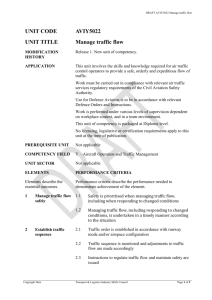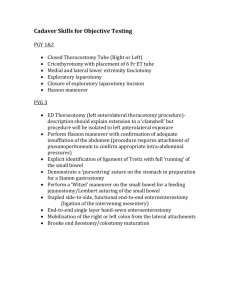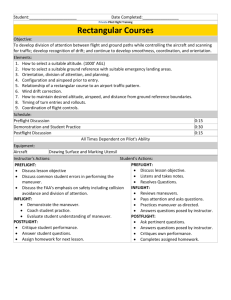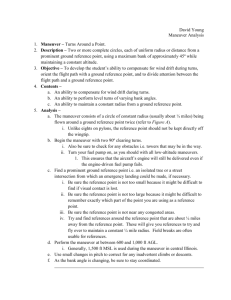Academy of Model Aeronautics
advertisement
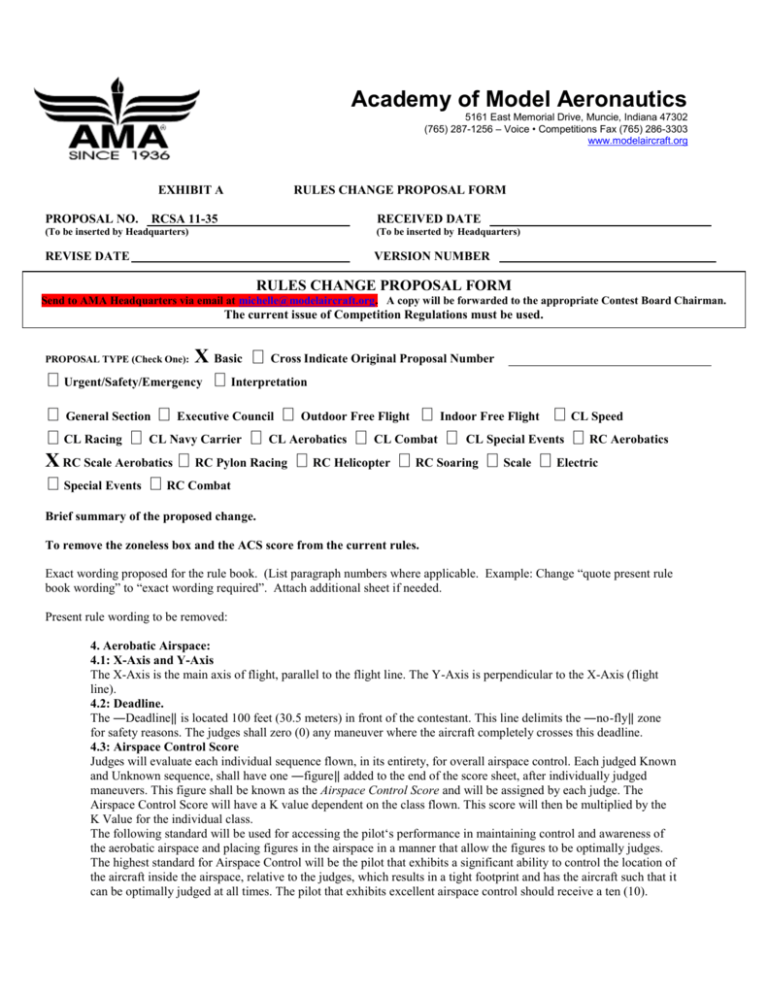
Academy of Model Aeronautics 5161 East Memorial Drive, Muncie, Indiana 47302 (765) 287-1256 – Voice • Competitions Fax (765) 286-3303 www.modelaircraft.org EXHIBIT A PROPOSAL NO. RULES CHANGE PROPOSAL FORM RCSA 11-35 RECEIVED DATE (To be inserted by Headquarters) (To be inserted by Headquarters) REVISE DATE VERSION NUMBER RULES CHANGE PROPOSAL FORM Send to AMA Headquarters via email at michelle@modelaircraft.org. A copy will be forwarded to the appropriate Contest Board Chairman. The current issue of Competition Regulations must be used. PROPOSAL TYPE (Check One): X Basic Urgent/Safety/Emergency General Section CL Racing Interpretation Executive Council CL Navy Carrier X RC Scale Aerobatics Special Events Cross Indicate Original Proposal Number Outdoor Free Flight CL Aerobatics RC Pylon Racing Indoor Free Flight CL Combat RC Helicopter CL Speed CL Special Events RC Soaring Scale RC Aerobatics Electric RC Combat Brief summary of the proposed change. To remove the zoneless box and the ACS score from the current rules. Exact wording proposed for the rule book. (List paragraph numbers where applicable. Example: Change “quote present rule book wording” to “exact wording required”. Attach additional sheet if needed. Present rule wording to be removed: 4. Aerobatic Airspace: 4.1: X-Axis and Y-Axis The X-Axis is the main axis of flight, parallel to the flight line. The Y-Axis is perpendicular to the X-Axis (flight line). 4.2: Deadline. The ―Deadline‖ is located 100 feet (30.5 meters) in front of the contestant. This line delimits the ―no-fly‖ zone for safety reasons. The judges shall zero (0) any maneuver where the aircraft completely crosses this deadline. 4.3: Airspace Control Score Judges will evaluate each individual sequence flown, in its entirety, for overall airspace control. Each judged Known and Unknown sequence, shall have one ―figure‖ added to the end of the score sheet, after individually judged maneuvers. This figure shall be known as the Airspace Control Score and will be assigned by each judge. The Airspace Control Score will have a K value dependent on the class flown. This score will then be multiplied by the K Value for the individual class. The following standard will be used for accessing the pilot‘s performance in maintaining control and awareness of the aerobatic airspace and placing figures in the airspace in a manner that allow the figures to be optimally judges. The highest standard for Airspace Control will be the pilot that exhibits a significant ability to control the location of the aircraft inside the airspace, relative to the judges, which results in a tight footprint and has the aircraft such that it can be optimally judged at all times. The pilot that exhibits excellent airspace control should receive a ten (10). The lowest standard for Airspace Control will be the pilot that exhibits a poor ability to control the location of the aircraft inside the airspace, relative to the judges, which results in an excessively large footprint and has the aircraft consistently so far away as to be difficult to properly judge. The pilot that exhibits very poor airspace control should receive a zero (0). Pilots exhibiting airspace control within the range of these two standards will be graded with a range of possible scores from ten (10) to zero (0) in whole point increments. The K factors for the Airspace Control Score are: Basic = 3K Sportsman = 6K Intermediate = 9K Advanced = 12K Unlimited = 15K Exact wording required: Rules Downgrade one (1) point for each deviation of: Judging criteria: Number of judges Scale Aerobatics 10 degrees (½ point for 5°) IAC 5 degrees Pattern 15 degrees Flight path 2 minimum Aircraft attitude 5 standard 3 minimum Flight path 2 minimum 4. POSITIONING Scale Aerobatics requires all scored maneuvers to be flown in front of the judges, in an area called the “box”. 4.1. Scale Aerobatics box Two (2) horizontal lines, 75 degrees to each side of the centerline, limit the box with the apex located at the contestant’s position. The total length of the box shall be 1800 feet (550 meters) along a line parallel to the flight line. The rear boundary of the box shall be a line parallel to the flight line and 1000 feet (305 meters) from the contestant’s position. If an entire maneuver including entry and exit is flown out of the aerobatic box, it must be zeroed. Judges must agree on the zero. Downgrades for flying a maneuver partially out of the zone should be in proportion to the degree of infraction, ie a small part of the maneuver (10%) flown past the 75 degree line would call for a minor downgrade (10%), perhaps one point, while more of the maneuver (say 30% or 40%) flown past the 75 degree line, must be downgraded more severely (30% or 40%), say three or more points. Although judging the side and back infringements are more difficult, judges should still take them into account if the aircraft clearly goes past these boundaries. In case of uncertainty, always give the competitor the benefit of the doubt. The front boundary of the box is not only limited by the two 75 degree lines, but also by another line running parallel to the flight line, located 100 feet (30.5 meters) in front of the contestant. This line delimits the ‘nofly’ zone and is also named ‘Deadline’ for obvious safety reasons. The judges shall zero (0) any maneuver where the aircraft completely cross this deadline. The flight line, or any line parallel to it is also called the “X-axis”. Any line perpendicular to it is also called “Y-axis” or “Cross-Box” lines. 4.2. Scale Aerobatics Zones The aerobatic box is equally divided into three (3) distinct and separate zones: a center one and two turn around zones, one on each side of center. The Aresti diagram defines the maneuvers and the zone in which each is to be flown. The maneuvering area shall be clearly marked with white (or contrasting color to the background) vertical poles, approximately 4 in diameter and approximately 16 ft high, placed on center and 75 degrees each side of center on a line approx 150m in front of the competitor’s position. Flags, streamers, or boards of contrasting color to the background, should be mounted on the poles to improve visibility. White (or contrasting) lines, originating at the competitor’s position and extending outward at least 100 feet, shall also be used to mark the centre and extreme limits (75 degrees left and right of centre) of the maneuvering zone. Audible and visual signals to indicate violations of the maneuvering zone must not be used. A center maneuver must be flown so that it is centered on the centre line and the centre flag. If the maneuver is flown off-centre, it must be downgraded according to the misplacement. This may be in the range of 1 to 4 points subtracted. Flying so far out as to make evaluation of a maneuver difficult should be severely downgraded. The main criterion here is visibility. For a large, highly visible model aircraft, a line of flight approximately 300 feet in front of the pilot may be appropriate, while a smaller less visible model aircraft might have to be flown at say 175 to 250 feet. Maneuvers performed on a line greater than approximately 350 feet in front of the competitor must be downgraded by at least one point.. Maneuvers performed on a line greater than 500 feet in front of the competitor must be downgraded more severely (in the order of 2 to 3 points). In general, turn-around maneuvers are positioning maneuvers. Therefore, entry and exit altitude need not be the same if the pilot wishes to make an altitude adjustment. Any part of any maneuver which is performed inside the deadline, will be justification for a zero score for that maneuver. Repeated infringements of the deadline, may result in the competitor being asked by the Contest Director or the judges, to terminate the flight due to safety reasons. Rolling Circles and Cross-box : The maximum 350 feet distance requirement is waived for rolling circles, and Cross-box maneuvers. A downgrade should only be applied if the far side of the circle or Cross-box exceeds approximately 1000 feet. 4.2.1. Center Zone Center zone maneuvers shall be performed so that the exact center of the maneuver is located on the centerline, which is a line perpendicular to the flight line in front of the pilot. Any deviation shall be downgraded using the standard half (.5) point per five (5) degree deviation, with a maximum of 2 point deduction (Fig. 1). If the sequence has multiple center zone (cross box) maneuvers occurring consecutively, the first (or entry) maneuver shall be centered based on the criteria defined later. The following maneuver shall not be subject to the centering criterion established above and may be flown with its center anywhere within the center zone. However, the track established between exiting one cross-box maneuver and entering the next one shall be perpendicular to the flight line (on the “Y-Axis”). Any deviation from a perpendicular track between the maneuvers will be downgraded .5 point for every 5 degrees of deviation. If the sun is positioned such that it hampers center positioning and judging of center maneuvers, the contestant may require the judges to allow an offset of the center maneuvers. This agreement shall take place prior to the start of the flight. Also, flying the center of a figure in the front or the back of the zone while on the X-axis is not a criterion for judging. Before entering the box, the pilot or caller should announce to the judges how the first maneuver will be entered (Left-to-Right or Right-to Left). This is completely the pilot’s option and independent of the wind direction. Once this announcement is made, the relationship and zone positioning between maneuvers is defined by the Aresti sequence drawing. Any maneuvers that are flown in the wrong zone must be zeroed. 4.2.1.1. Center of maneuver Being able to correctly assess the center of a complex maneuver is critical to establish the appropriate downgrade when this maneuver is flown in the center zone. The first two elements of a complex maneuver will determine where the center of the whole maneuver should be located. Logic behind proposed change, including alleged shortcomings of the present rules. State intent for future reference. Back in 2004, the IMAC BOD with Tom Wheeler as President, introduced the zoneless box and what is now known as the ACS score, for two reasons. Those reasons were to “reduce the overall footprint by adapting this rule change now. It also of course gets us back in line with full scale CIVA and IAC”. It is important to note that this change was not done by vote of the IMAC membership, and as such, in itself has remained a serious point of contention within the IMAC community. In reality the zoneless box has not reduced our footprint, and in fact has had the opposite effect. Our aircraft have been steadily increasing in size, with 40% and larger being commonplace even in the Basic Class. The current criteria is not capable of controlling our footprint. How can we possibly begin to control it, when there are no dimensions for the space or box we are to fly in? The ACS score while good intentioned, has been ineffective. There is no definitive criteria for calculating a proper score. What does “which results in an excessively large footprint and has the aircraft consistently so far away as to be difficult to properly judge,” mean exactly? Does it mean that if the judge needs binoculars to see it, it should be given a low score? With 40% and larger aircraft, one can still plainly see theses size of aircraft a half mile or more away. Clearly that is way too far, and unacceptable. This has had a very disturbing impact on the ability of clubs to host contests, and as a result, a number of contests have been permanently lost due to overfly and / or noise issues. In addition, some clubs have gone so far as to ban Scale Aerobatics from their field’s altogether, including practice flying. Who can blame them…? All it takes is one complaint from a neighbor, and any flying field can be lost. I would ask you all who will decide on this RCP, how does this promote the hobby, the AMA, or Scale Aerobatics? How would this increase the AMAs or IMACs membership if there are fewer and fewer contests? While it is one of Scale Aerobatics goals to emulate full scale Aerobatics as close as possible, not everything that applies to full scale can or should apply to Scale Aerobatics, and this is indeed one of those cases. NOTE: If the Rolling Circle to Rolling Loop RCP becomes a rule, all references to rolling circled in this RCP should be removed. Effect, if any, on current AMA records. No known effects on current AMA records. Note: The Contest Board Chairman may, in coordination with the submitter of the proposal, at any time prior to submitting a proposal to the Contest Board for Final Vote, edit proposal wording to increase clarity and to avoid ambiguity provided the proposal intent is not changed. 1. Proposer: James R. Woodward AMA # 638975 Street Address: 1502 Jason St. City: Albertville State: AL Zip: 93590 Day Telephone : 256.677.8819 Evening Telephone (_____)___________________ Date of Signature: 31MAR10

